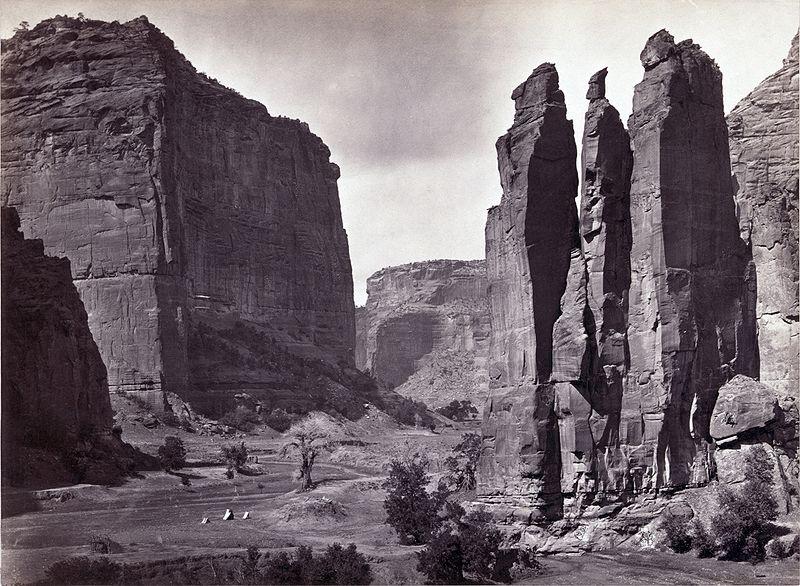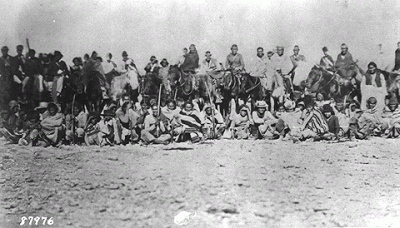Showing posts with label Indian wars. Show all posts
Showing posts with label Indian wars. Show all posts
Monday, July 28, 2014
Battle of Killdeer Mountain
150 years ago today an important battle was fought between the United States and the Sioux Indians. Read about it on Discerning History.
Labels:
Indian wars
Monday, January 6, 2014
Kit Carson Fights the Navajo
 |
| Kit Carson |
 |
| Fort Sumner |
 |
| General James Carleton |
You have deceived us too often, and robbed and murdered our people too long, to trust you again at large in your own country. This war shall be pursued against you if it takes years, now that we have begun, until you cease to exist or move. There can be no other talk on the subject.Carson wanted to pursue a more mild approach. With the threat of resignation Carson got the plans moderated, but they still called for a scored earth policy toward the Navajo. His force was made up of friendly Indians and New Mexico volunteers. The fighting with the Navajo did not involve pitched battles. It was made up of several months of raids. Carson used the Indians' crops and destroyed the rest, and captured all the prisoners he could send to Fort Sumner.
 |
| Navajo riding through Canyon de Chelly |
 |
| The Canyon |
 |
| Navajo |
Labels:
battle,
campaign,
Indian wars,
New Mexico
Tuesday, January 29, 2013
Bear River Massacre
| Patrick Conner |
Abraham Lincoln was worried the new state of California would be cut off from the United States as it was bordered by Utah Territory, and the loyalty of the Mormon militia there was doubtful. Therefore he ordered several regiments of California troops to be raised to defend the area. One of these was the 3rd California Volunteer Infantry, which moved to the Salt Lake City area to keep the peace. The 3rd California was commanded by Patrick Conner, an Irishman who immigrated to America and joined the army, fighting in the Mexican and Indian wars.
There were several incidents of violence between the settlers and the Shoshone Indians in the preceding years. In early December, 1862, Col. Connor sent Major Edward McGarry on an expedition into the Cache Valley to recover some livestock thought to have been stolen by the Shoshone. The Indians fled at the soldiers' approach and all made their escape, except for four warriors. Although they did not seem to be the thieves, McGarry said that if the livestock was not returned by the next day, the Indians were to be executed. It was not, and so the four men were executed by firing squad.
| Settlers |
Conner was in position on January 28th, and he had his men moving for a surprise attack at 3:00 am on the morning of January 29th, 150 years ago today. It was the dead of winter and even colder than usual, the temperature that morning may well have been around -20° F. The first American units arrived at the camp at around 6:00 am. The Indians were unprepared for the attack. They thought that the United States would try to negotiate, instead of resorting to an attack. However, when Conner's men attacked, their advance was halted by the Shoshone fire. Conner sent McGarry around to flank the village, and positioned a line of troops to block any attempt to escape.
| Site of the massacre |
Some Shoshone had escaped. Chief Sagwitch was shot in the hand, and escaped on horseback. His horse was killed, and he survived by floating in a hot spring, hidden under some brush. Estimates of Shoshone casualties vary. Connnor reported killing 224 of 300 braves and capturing 160 women and children. Many years later a settler reported counting 493 Indians killed, and the son of the chief said that half of the Indians escaped, and 156 were killed. Whatever the death toll, the Shoshone tribe was destroyed. Chief Sagwitch and the survivors of the tribe joined the Mormon church.
Labels:
battle,
Indian wars,
territory


